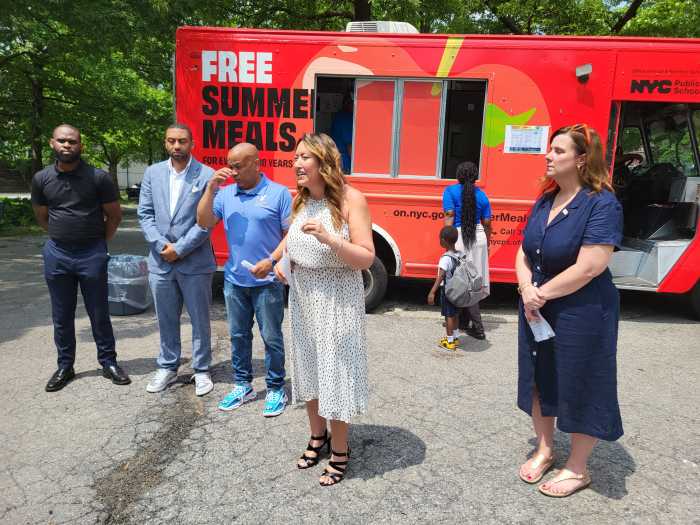BY Aline Reynolds
Printmaker Bill Tropp works to the sound of drilling and hammering outside his window.
It’s not the noise that bothers him. Tropp has experienced a 40 to 50 percent drop in profits in the last two years due to ongoing construction right outside his fourth-floor shop at 181 Broadway.
“The biggest problem we have is for deliveries,” he explained. “We have to use trucks to get paper in, and it’s virtually impossible to park here.”
Tropp may be forced to close the business his grandmother founded in 1953 if relief doesn’t come soon.
“We want to stay here,” he said. “We wouldn’t know where else to go.”
Tropp is among a host of Downtown business owners who have lost customers from disruptive street construction projects in the area. Help could be on the way though, in the form of additional financial support from the Lower Manhattan Development Corporation. On Wednesday the L.M.D.C. announced it will support more small firms below Canal Street that have suffered financially from publicly-funded construction projects that last 13 months or longer.
Around 130 new businesses could qualify for a piece of the funding under the new guidelines, which take effect immediately. Previously, to receive funding through the program, a business had to be on the ground floor.
“The rebuilding of Lower Manhattan has made it tough for small business owners who have seen foot traffic diverted because of construction-related street closures,” said Avi Schick, Chairman of the L.M.D.C. “By expanding eligibility and extending the program for another five years, we will be able to assist many more businesses, helping to preserve Downtown’s retail sector.”
The extra $1 million was added to an already-existing grant program, the Small Firm Assistance Program, created in 2008. So far, the L.M.D.C. has awarded $3.1 million of S.F.A.P. grants to 150 small businesses in Lower Manhattan.
“As a former small business owner, I can truly tell you that small business is the backbone of this community,” said Community Board 1 chair Julie Menin. “They not only give revenue obviously to the City of New York, but they provide needed services to residential, commercial and tourist populations which is so incredibly important.”
Per the community’s request, the L.M.D.C. is expanding its already-existing program to $6 million and increasing the maximum allowance per grant to $35,000, from $25,000. Companies that apply for the money must prove a loss in revenues during the construction period.
“Projects such as the Fulton Street Transit Center are crucial to the future of our community and will bring enormous benefit to residents and businesses alike down here,” said Assembly Speaker Sheldon Silver. “But… the major construction projects… have proven costly for our business owners, and that’s why this program was established in the first place.”
Congressman Jerrold Nadler said, “I am so pleased that L.M.D.C. will be expanding the [program]. Nine years after the attacks of 9/11, many Lower Manhattan small businesses have continued to struggle as a result of ongoing construction projects in our efforts to rebuild downtown. These small businesses are the backbone of Downtown’s revitalization, and our ongoing support is critical to the success of this area’s resurgence.”
Red Line Studios, which has a 2,500 square-foot space one floor below Tropp printmaking, has lost approximately 50 percent of its TV studio clients since construction on Broadway began five months ago.
“We lost a $50,000 job about a week ago because the client was intimidated by all the construction,” said Matthew Pellowski, Red Line’s director and producer. The company moved shop from Brooklyn in 2008.
Red Line would purchase much-needed soundproofing with the grant money, which Pellowski said would attract clients who are looking for a quiet studio in which to film.
Tropp and Pellowski plan to stick it out through the tough times.
“We love it here,” Pellowski said. “We don’t regret [moving to Downtown] at all, it’s just we’re trying to get through these difficult times of recession and construction, and all the inconveniences.”
“We want [construction] to continue,” Tropp said. “But we want to make sure that those businesses like us who choose to stay here can get through it.”
This isn’t the first time the S.F.A.P. has been expanded. Community Board 1 passed a resolution in April 2009 asking that the grant encompass a greater number of small merchants. By July of last year, businesses on all (not just some) streets under construction became eligible for the grant, and merchants on adjacent streets also became grant candidates. Also, the amount each business could receive per square foot doubled from $2.50 to $5.
“I’m very, very happy with the outcome,” said C.B. 1 financial district committee chair Ro Sheffe, who chaired the board’s 2009 subcommittee dedicated to expanding the program. “I think it’s ultimately a very good example of how government and advocacy groups can work together for the betterment of the community.”
The L.M.D.C.’s small firm program, originally set to terminate at the end of 2010, will now sunset in 2015.

































